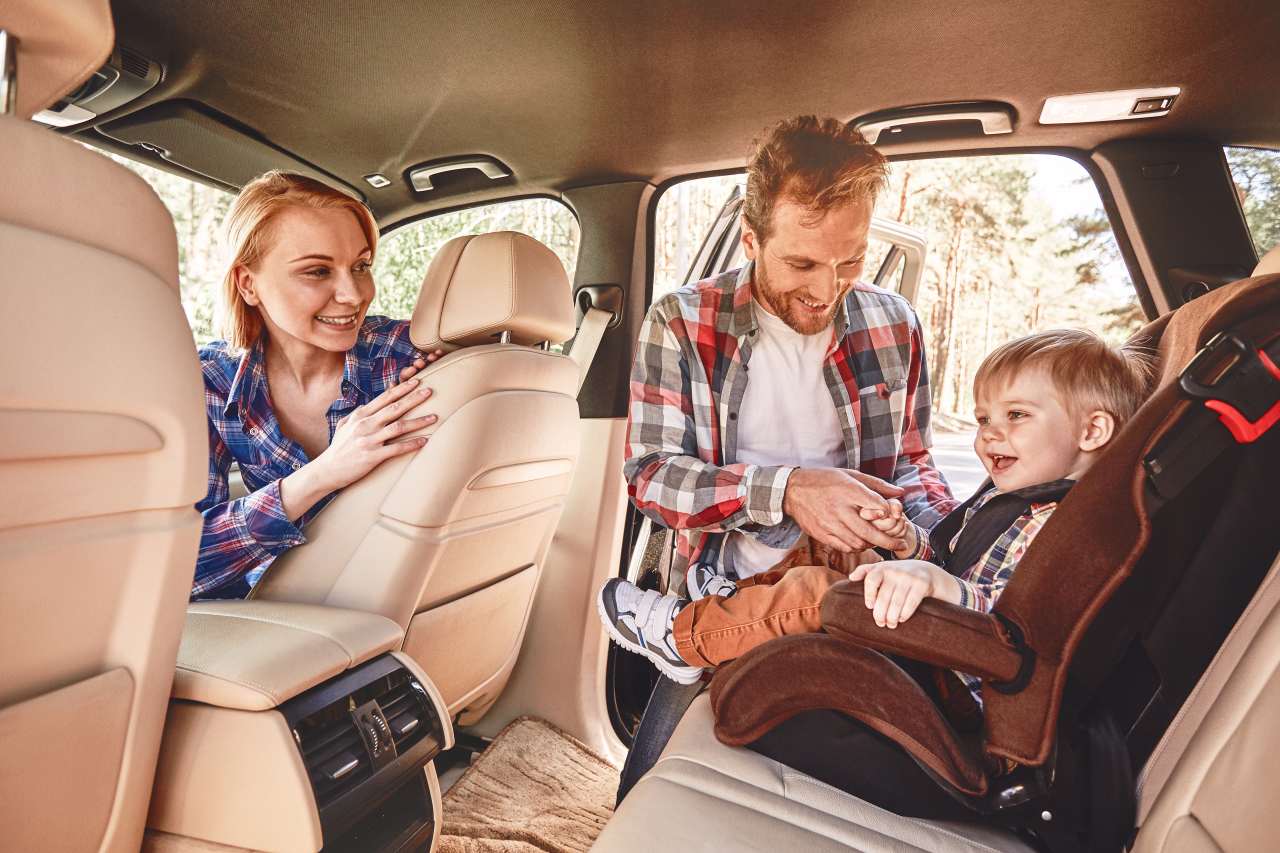This stylish, champagne-coloured EV is the Polestar 2. It’s a mid-sized competitor to the Tesla Model 3 and Kia EV6 and hails from Sweden.
In fact, you may recognise some of its features, and that’s because Polestar is brought to you by the friendly folk at Volvo.
It sports the clean designs and quality finishes we’ve come to know from Volvo. But is this enough to get past some of the quirks and impracticalities I experienced during testing with my family over two weeks?
Is its minimalistic form ‘too’ minimalistic, and does it come at the expense of function?
The test Polestar 2 is the Long range Single motor and starts at $68,400, before on-road costs.
It’s fitted with the ‘Pilot Lite Pack’ for an extra $3400, and the $6000 ‘Plus Pack’. More on both of those later. So (before on-roads) this particular car is going to cost just under $80,000.
Keen to find out if it’s right for your family? Keep reading!
Polestar 2 2023: Long Range Single Motor 78KWH
| Engine Type | 0.0L |
|---|---|
| Fuel Type | Electric |
| Fuel Efficiency | 0.0L/100km (combined) |
| Seating | 5 |
| Price From | $50,380 - $57,970 |
| Safety Rating |
|
What does it look like?
The design of the Polestar 2, like a lot of EVs, has that futuristic look, but it’s not over-the-top. Will it age gracefully? Maybe not, but for right now, it looks really cool.
I like the way the interior isn’t finished with your standard leather or hard plastics, and that the combination of different textured materials compliment each other, adding to the modern look of the entire car.
I especially like the 3D etched deco material and the hexagon shaped gear shifter. But, although the gear shifter looks good, it tends to get in your way when reaching for the home button on the multimedia screen.
Another thing that gets in the way is the floor in the driver’s footwell. It is unusually high which feels a bit odd when resting your left foot away from the foot rest.
.jpg)
I guess you get used to these kinds of things over time and maybe I just haven’t experienced enough EVs with big batteries under the floor, but personally I didn't find the cabin particularly comfortable.
It comes with 19-inch alloy wheels, which are standard, and the test car's 'Jupiter' colour will cost you an extra $1500! There are six colours to choose from, while 'Magnesium', a silver shade, comes at no extra cost.
If you look up, you'll see the fixed panoramic sunroof (no, it doesn’t open). Surprisingly, the cabin didn't get any hotter being parked in the sun compared to other cars, but it does let in a lot of light which was great until I needed to get my baby to sleep or keep the sun off his face.
The only option to darken the cabin is to purchase a separate roof sunshade that attaches with clips.
.jpg)
Let’s talk about the head restraints. They look odd and aren’t comfortable when your seat is in a more upright position.
For us, with the rear facing capsule installed behind the passenger seat, the front seat needed to go further forward in order to get a comfortable enough recline to avoid our heads being pushed forward.
A quick browse of Polestar internet forums will reveal this is a common complaint, even for owners without baby seats installed.
One last thing. Up in the roof (on the inside) there is a small cut out that reflects the Polestar logo. This looks cool, but surely a flip down sunglass holder would be a more practical alternative.
How does it drive?
The Polestar 2 Long range Single motor is front-wheel drive with a 400V Lithium-ion battery delivering a range of up to 540km.
As an EV newbie, it took no time at all to become accustomed to the golf cart feel when I put my foot on the accelerator, and I was surprised by the lack of road noise.
It’s pleasantly quiet in the cabin. It feels great to drive, the steering is nice and firm and with its low centre of gravity (a common EV characteristic), it handles corners effortlessly.
It has 'One Pedal Drive' which I just couldn’t get a handle on after a couple of goes, but most owners would probably adapt to if used every day.
.jpg)
Basically, the motor becomes a generator slowing the car once you lift your foot off the accelerator and adding charge to the battery in the process.
The rear window is quite narrow and restrictive to see out of, but the reversing and 360-degree view cameras help make up for what you can't see.
I found it annoying only having one camera option at a time while reversing, though. Every other car I’ve driven with a 360-degree camera has had a split screen showing two views concurrently, and it's not like the screen in this car isn't big enough for it either!
The sensors are quite sensitive and I found I always parked much further away than necessary as the camera views and the proximity warnings suggest you are closer than you actually are.
.jpg)
Ultimately, there was plenty that bugged us living with this car for two weeks, but did we ultimately manage to make it work for us? Yeah.
The motor has a range of up to 540km, but the harder you drive, the less distance you will get out of the battery. Polestar claims an efficiency of 17.1-18.6kWh per 100km and in my two weeks of mixed driving, I managed 17.9kWh/100km. Not bad!
One thing I enjoyed about using Google Maps with the Android Automotive system, is it forecasts the percentage of charge your battery will have available when you arrive at your destination, as well as when you return home.
A pretty smart feature, if you ask me. It makes it easy to predict if you’ll need to find a charger while out and about or not.
.jpg)
I picked this car up on a Thursday, late morning, drove 40 minutes home along a highway and over the next three days only took short trips around my local area for day care drop-off and pick-up, grocery shopping, and running errands. And by Sunday evening, I was already down to 67 per cent.
Thankfully, there is a fast charging point just down the street from my home (conveniently, next to a cafe), so even though I was surprised at how quickly the battery depleted, I never felt any range anxiety.
And with it only taking 37 minutes to charge from 10-80 per cent, that gave me just enough time to grab a coffee and go for a walk around the block.
It, of course, comes with an adaptor cable to plug it in at home, but it's very slow and unless you have a fast charger installed, you’d want to make sure it’s plugged in overnight regularly to maximise your range at the start of each day.
How spacious is it?
The cabin space is just too small for a family using child seats. But if your kids are older and no longer in child seats, the space is livable.
The boot is a decent size. I could fit our standard sized pram in lengthways with three very full grocery bags.
A handy lid which divides the boot space comes extra with the Plus Pack, and it’s great for stopping groceries sliding around, among other things.
.jpg)
You get 405-litre boot capacity, including 41L in a floor compartment with the back seats in use.
With the seats folded down, you get 1095L, including the 41L in the floor. But, bear in mind that includes space all the way up to the roof. The front storage space under the bonnet is also 41L.
Overall, it’s not a huge space when comparing it to a medium-sized SUV, but it is definitely enough for my day-to-day mum life, and with the liftback tailgate it's easy to lift heavy things in and out of. The electric tailgate has a soft close, which is a nice touch, too.
.jpg)
I must also mention, the Polestar, like Tesla and Hyundai EVs, saves weight and space by having a tyre repair/inflator kit instead of a spare or space saver.
At first I thought it was a silly idea. But when you think about an EV, you’re not often doing long country drives, far away from civilisation, mainly because there just aren't enough charging stations around yet.
If you're unlucky enough to be dealing with a puncture, you can use the repair/inflator kit, which will be enough to get you to a nearby tyre shop.
How easy is it to use every day?
Do bear in mind I'm reviewing this sedan specifically to see if it can work for a young family. I’ve got a seven-month old and three-and-a-half year old.
So, was the Polestar 2 practical for us? Well, no. It is massively lacking in storage.
In the front row, you get an averaged sized glove box, two little cubbies either side of the centre pillar, which is where we stored our sunglasses. And there are two cupholders.
But weirdly, one is in the centre console bin deeming the space useless as a permanent storage compartment.
It does have a small cut out, big enough to store the key fob or your garage remote, and next to the wireless charging pad is another spot for your passenger’s phone or your wallet.
You have some space in the doors, but annoyingly, they don’t keep drink bottles standing upright.
.jpg)
Then, the rear row is so impractical for a family. If your kids were no longer in child seats, this car might work. But the sunk-down, almost sports car style bucket seats just don't work for family life.
We needed to shove a towel under one end of our baby capsule to keep it within the recommended recline range.
The outboard seats have ISOFIX restraints and all three have top tether harness restraints, not that you would fit three child seats back here. You probably wouldn’t even get two side-by-side. Something to consider for your family.
Installing our car seats was a big pain. You definitely wouldn’t want to be interchanging your child seats regularly.
The rear head restraints don’t move up and down, or at least I couldn’t get them to move. You need to squeeze the anchor through a tiny slot gap to feed the strap through to the anchor point.
Then it’s nigh on impossible to tighten a capsule tether without contorting your wrist. It became a sweaty job and I’ll be glad to never fit a child seat in this car again.
.jpg)
After a few negatives, I did find something that was great for parent life. The hard plastic on the back of the front seats. Perfect for toddlers with over-active legs!
The storage in the back seat isn’t too bad. You have two cupholders in the centre armrest, space in each door for small water bottles, and map pockets behind the front seats which strangely only come with the ‘Plus’ option pack.
There’s a reading light, two coat hooks on each side and directional air vents. The doors open nice and wide, and although not quite to 90 degrees, they were easy to wrangle the kids in and out through.
One thing my toddler didn’t enjoy was how high the window sill is. He struggled to see out and on a long drive when he was already grumpy, it made it hard to distract him with things to look at outside. I know other parents will understand this as being something to deduct points over.
Overall, it gets the job done, but for my family, I want more than this. I want ease, convenience, effortlessness and well thought-out designs to minimise the list of things I need to think about every day, even just by a little, and I didn't get that with the Polestar 2.
How safe is it?
I mentioned earlier that this car has the Pilot Lite Pack for an extra $3400, and you may be asking, what is that? Well, it’s a bunch of the active safety features I couldn’t live without and that a lot of new cars come standard with these days.
I would absolutely add this pack on, but I'd feel pretty dirty having to pay extra for what is now becoming standard. Some of these optional safety features are blind-spot information with steering support, rear cross-traffic alert with brake support, rear collision warning and mitigation, adaptive cruise control and 360-degree camera view.
Keep in mind, though, its main competitor, the Tesla Model 3 doesn't come with these safety features, either.
.jpg)
The adaptive cruise control isn’t as reactive as I’ve become used to and I didn’t feel comfortable relying on it to brake quickly enough whenever a leading car slowed abruptly.
Sure, I know in reality it would keep me safe (it’s designed by Volvo, after all) but for some reason I just didn’t feel as confident with this system as with others.
Standard are eight airbags, collision avoidance and mitigation with braking and steering support (with vehicle, cyclist and pedestrian detection) and forward collision warning, just to name a few. It also received the full five-star ANCAP safety rating, as tested in 2021.
What’s the tech like?
The $6000 'Plus Pack' comes with some comfort and design features like the ‘Wave Tech' seats (Polestar's own vegan fabric) in 'Charcoal' or 'Slate' with 'Ash' decor inlays.
But there's some extra tech stuff, too, like fully electric seats (with four-way lumbar support), a heated steering wheel, front cushion leg extension, a Harmon Kardon sound system, high-level interior illumination, wireless charging (which wasn’t very reliable with our Samsung phones), and ‘Air quality’ advanced cabin sensor and filter.
Aside from the added options, standard features include the 11.2-inch centre display, four USB-C charging points (two up front and two in the rear), dual-zone climate control, heated front seats, an in-built SIM, Google Assistant, Google Maps and Google Play Store.
That said, so far there’s a very limited range of apps available and that’s because there aren’t many compatible with the new-ish Android Automotive operating system this car is running.
.jpg)
Don’t confuse this with ‘Android Auto’ or ‘Apple CarPlay’, neither of which are an option here. Rather, Android Automotive is like having an Android tablet controlling all of your car's settings and media, except that right now it’s limited in what it can do due to its relative infancy.
For example, it won’t yet read out your Whatsapp messages as Android Auto does. The more I drove this car, the more frustrated I became with the multimedia system which was a huge surprise as I’m very familiar with Android products.
I found it unintuitive and the labelling on the steering wheel buttons is vague. Both will take time to sit down, work out and get used to.
In almost every car I’ve driven, I’ve been able to work out what and where most things are after a few drives. But after almost two weeks, this media screen still had me scratching my head.
The steering wheel, on the other hand, will become second nature once you remember which button does what.
How much does it cost to own?
Polestars come with a five-year, unlimited kilometre vehicle warranty. The battery has an eight-year or 160,000km warranty, whichever comes first.
If the battery capacity reduces below 70 per cent within the first eight years, it will be replaced free of charge. The battery also has a 12-year corrosion warranty, if corrosion is due to faulty materials.
Polestar has a five-year or 100,000km complimentary service plan with five-year roadside assist included. Service is every 24 months or 30,000km, whichever occurs first.
.jpg)
Verdict
As a family with two small kids, the Polestar 2 isn’t practical for us. The lack of cabin storage is inconvenient, the multimedia system lacks customisation and features, and the rear seats and head restraints aren’t child seat-friendly.
Even for a couple with no kids, there seems to be too many impractical and annoying design features to live with every day. But hey, maybe it’s worth putting up with to save a few thousand dollars, or more, against the next best option.
And at the end of the day you’ll have to make up your own mind on that. But for my family, it wouldn’t be our first pick on a short list of EVs. As a family car, unfortunately, I’m scoring the Polestar 2 a three out of five.



.jpg)
.jpg)














.jpg)
.jpg)
.jpg)
.jpg)
.jpg)
.jpg)